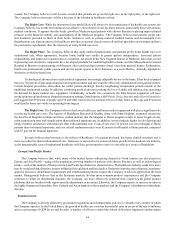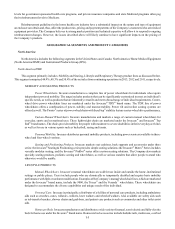Invacare 2013 Annual Report Download - page 20
Download and view the complete annual report
Please find page 20 of the 2013 Invacare annual report below. You can navigate through the pages in the report by either clicking on the pages listed below, or by using the keyword search tool below to find specific information within the annual report.I-14
During 2013, the Company initiated a power wheelchair joystick recall, which involves the replacement of the potentially
affected joysticks, which are sold globally. The power wheelchair joystick performance issue relates to an anomaly discovered in
a portion of the components in the field. The Company has a warranty reserve for this power wheelchair component recall, which
is discussed further in the "Current Liabilities" and “Contingencies” Notes to the Condensed Consolidated Financial Statements
included in this Annual Report on Form 10-K.
The Company occasionally sponsors scientific studies, usually involving its respiratory therapy products. These studies have
historically been bench studies using situation models to validate and compare device performance against competitive products.
Such studies have been published as abstracts and/or manuscripts in peer reviewed science journals.
Affordable Care Act.
The U.S. Patient Protection and Affordable Care Act of 2010 (Affordable Care Act), included a number of provisions affecting
the HME industry. In addition to expanding the Medicare National Competitive Bidding (NCB) program from 70 to 91 geographic
bid areas, Medicare now makes rental payments for 13 months before the beneficiary assumes ownership of a standard power
wheelchair. The Affordable Care Act imposes a “productivity adjustment” to the annual fee schedules of all Medicare providers,
including HME providers, that limits any annual cost of living increases applied to the fee schedules. The Affordable Care Act
also included an excise tax on U.S. sales of medical device manufacturers or importers, such as Invacare. The 2.3% sales-based
excise tax on medical device manufacturers or importers began on January 1, 2013. The excise tax does not apply to medical
devices that the Secretary of Treasury determines are generally purchased by the general public at retail for individual use. In
December 2012, the Internal Revenue Service issued final regulations related to the 2.3% excise tax, and in particular, the application
of the retail exception. The excise tax is deductible by the manufacturer or importer on its federal income tax return. The Company
has reviewed the final regulations and believes that most of its products are exempt from the tax based on the retail exemption
provided in the Affordable Care Act as defined in the regulations. The Company has determined that certain products that it sells
for institutional use are subject to the excise tax. Based on its interpretation of the regulations, the impact of the tax was $400,000
in 2013. The Company was able to pass a majority of this tax on to the market.
National Competitive Bidding.
With respect to reimbursement in the United States, the Centers for Medicare and Medicaid Services (CMS) began
implementation on January 1, 2011 of the National Competitive Bidding (NCB) program in nine metropolitan areas across the
country (Round 1). On July 1, 2013, CMS expanded the program to an additional 91 metropolitan areas (Round 2). These bid
programs have resulted in new, lower Medicare payment rates in these 100 areas. CMS rebids these areas every three years and
hence a second round of contracts began in the nine Round 1 areas on January 1, 2014. The Company remains judicious in its
extension of credit to customers and monitors whether other payors begin to model their payments on the NCB program. The
Company also closely watches state Medicaid budgets and how deficits may impact coverage and payments for home medical
equipment and institutional care products.
Although reductions in Medicare payments are not beneficial to the homecare industry, the Company believes that, over the
long term, it can still grow and thrive in this environment. No significant cost-of-living adjustments have been made over the last
few years to the reimbursement and payment amounts permitted under Medicare with respect to the Company’s products, but the
Company intends to respond with improved productivity. In addition, the Company’s respiratory therapy products (for example,
the low-cost HomeFill® oxygen delivery system) can help offset the Medicare reimbursement cuts to the homecare provider. The
Company intends to focus on developing products that help the provider improve profitability. Additionally, the Company continues
to focus on low-cost country sourcing and/or manufacturing to help ensure that the Company is one of the lowest cost manufacturers
and distributors.
BACKLOG
The Company generally manufactures most of its products to meet near-term demands by shipping from stock or by building
to order based on the specialty nature of certain products. Therefore, the Company does not have substantial backlog of orders of
any particular product nor does it believe that backlog is a significant factor for its business.
EMPLOYEES
As of December 31, 2013, the Company had approximately 5,400 employees.
























